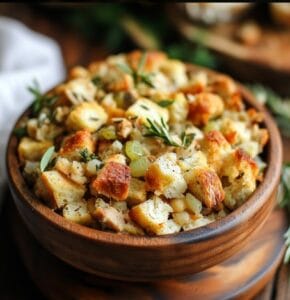Introduction
If you’ve ever asked, what is traditional dressing made of, you’re in the right place. Dressing is a classic dish often associated with Thanksgiving and family gatherings. It’s a flavorful mix of simple ingredients, combining comfort and tradition in every bite. Whether you’re curious about its history, variations, or how to prepare it perfectly, this guide has you covered.
What Is Traditional Dressing Made Of?
Traditional dressing typically consists of bread, aromatic vegetables, herbs, and a moistening agent like broth or butter. It’s baked to perfection, offering a balance of savory flavors and a soft yet slightly crispy texture. Variations may include ingredients like sausage, nuts, or dried fruit, but the basics remain the same.
Key Ingredients in Traditional Dressing
- Bread Base
- Bread is the foundation. Traditional recipes use day-old white bread, cornbread, or sourdough.
- The bread should be dried out or toasted to help absorb flavors.
- Aromatic Vegetables
- Onions, celery, and garlic are classic aromatics.
- These vegetables provide a savory base and complement the herbs.
- Herbs and Spices
- Sage, thyme, and parsley are common choices.
- Poultry seasoning often enhances the flavor profile.
- Liquid for Moisture
- Chicken or vegetable broth is typically used to moisten the bread mixture.
- Melted butter adds richness and flavor.
A Brief History of Traditional Dressing
Dressing has its roots in European cuisine and evolved as it made its way to the Americas. While stuffing was originally cooked inside poultry, dressing became a separate dish, gaining popularity in the Southern United States. The key difference lies in the cooking method—dressing is baked in a dish, while stuffing is cooked inside the bird.
What Makes Dressing “Traditional”?
- Simplicity: Traditional dressing relies on basic ingredients like bread, herbs, and vegetables.
- Flavor: The combination of aromatics and seasonings provides a timeless taste.
- Texture: A mix of soft and crispy textures makes traditional dressing unique.
Step-by-Step Guide to Making Traditional Dressing
Prepare the Bread
- Cut the bread into cubes and leave it out overnight to dry.
- Alternatively, toast the bread in the oven for 15 minutes.
Cook the Aromatics
- Sauté onions, celery, and garlic in butter until soft and fragrant.
Combine Ingredients
- Mix the bread, cooked vegetables, and herbs in a large bowl.
- Add broth gradually, ensuring the mixture is moist but not soggy.
Bake to Perfection
- Preheat the oven to 350°F.
- Spread the mixture in a greased baking dish and bake for 30-40 minutes, until golden brown on top.
Common Variations of Traditional Dressing
Southern Cornbread Dressing
- Uses cornbread as the base instead of white bread.
- Often includes sausage or bacon for extra flavor.
Gluten-Free Dressing
- Replaces traditional bread with gluten-free alternatives like rice or gluten-free bread.
Vegetarian Dressing
- Substitutes chicken broth with vegetable broth.
- Includes mushrooms or nuts for added texture and taste.
Tips for Perfect Traditional Dressing
- Use a mix of bread types for a more complex flavor.
- Adjust the amount of broth based on your preferred texture.
- Add a pinch of nutmeg or paprika for a subtle spice.
Common Mistakes to Avoid
- Over-saturating the Bread
- Too much liquid can make the dressing mushy. Add broth gradually.
- Skipping the Herbs
- Fresh or dried herbs are essential for flavor. Don’t skimp on them.
- Underbaking
- Ensure the top is golden and slightly crispy before removing it from the oven.
Healthier Alternatives to Traditional Dressing
- Use whole-grain or low-carb bread to make it healthier.
- Substitute butter with olive oil for a lower-fat option.
- Add more vegetables to increase fiber and nutrients.
Serving Suggestions
Traditional dressing pairs well with:
- Roast turkey or chicken.
- Gravy or cranberry sauce.
- Mashed potatoes or roasted vegetables.
Storing and Reheating Dressing
- Storing Leftovers
- Store dressing in an airtight container in the fridge for up to 3 days.
- Freezing
- Dressing can be frozen for up to 3 months. Defrost overnight before reheating.
- Reheating
- Warm in the oven at 300°F, covered with foil to retain moisture.
What Is Traditional Dressing Made Of?
Traditional dressing is a beloved dish that graces many family dinner tables, especially during holidays. It combines simple yet flavorful ingredients to create a side dish that pairs perfectly with poultry, roasts, or even as a standalone dish.
Key Ingredients of Traditional Dressing
The components of traditional dressing vary by region and family tradition, but some staples remain consistent:
- Bread Cubes or Cornbread: The foundation of dressing, often toasted or slightly stale to absorb the liquid. Cornbread is a common choice in Southern recipes.
- Chicken or Turkey Stock: Adds moisture and flavor, bringing the dressing together.
- Vegetables: Onions, celery, and sometimes carrots are sautéed for aroma and texture.
- Herbs and Seasonings: Sage, thyme, parsley, and sometimes rosemary provide a classic flavor.
- Eggs: Often used to bind the ingredients and add richness.
For more detailed insights into making chicken dressing, check out what chicken dressing is made of.
Preparation Process
- Toast or Prep the Bread: Use cubed, day-old bread or cornbread as the base.
- Sauté Aromatics: Cook onions, celery, and other vegetables in butter until tender.
- Mix Ingredients: Combine bread, vegetables, herbs, and eggs in a large bowl. Gradually add stock until the mixture is moist but not soggy.
- Bake: Spread the mixture in a greased baking dish and bake at 375°F until golden brown on top.
Learn more about variations with this chicken dressing recipe.
Customizing Your Dressing
- Add Proteins: Incorporate sausage or shredded chicken for a heartier dish.
- Make It Vegetarian: Swap chicken stock for vegetable broth.
- Experiment with Herbs: Add a mix of fresh and dried herbs for a more robust flavor.
For ideas on repurposing leftovers, explore recipes for leftover rotisserie chicken.
Final Thoughts
Traditional dressing is a versatile, comforting dish that can be easily adapted to suit any taste. Whether you follow classic recipes or add your own twist, this timeless side dish is sure to be a hit at any gathering. For additional tips, check trusted resources like Martha Stewart or The Kitchn.
Frequently Asked Questions
1. What Is Traditional Dressing Made Of?
Traditional dressing is a savory dish composed of bread, aromatic vegetables, herbs, and a moistening agent like broth or butter. The beauty of this dish lies in its simplicity and versatility. The bread acts as the base, soaking up all the flavors, while vegetables like onions and celery bring a rich, aromatic flavor. Herbs such as sage and thyme add a classic, earthy aroma that elevates the dish. Whether you’re making a classic recipe or adding your personal touch with extra ingredients like sausage or nuts, the core ingredients remain the same. Understanding these basics ensures you can master the dish and make it your own.
Benefit: Knowing the key ingredients allows you to customize the recipe to your taste preferences and dietary needs.
2. Can I Make Traditional Dressing Ahead of Time?
Yes, traditional dressing is perfect for prepping in advance. To make it ahead, assemble the ingredients in your baking dish but don’t bake it yet. Cover it tightly with foil and refrigerate for up to 24 hours. When you’re ready to serve, let it sit at room temperature for 20 minutes before baking as instructed. This method not only saves time on the day of your event but also allows the flavors to meld together, making the dish even more flavorful.
Benefit: Prepping ahead reduces stress and gives you more time to focus on other dishes or enjoy your gathering.
3. How Do You Keep Dressing Moist?
To keep dressing moist, add broth gradually until the mixture is damp but not soggy. Baking it covered with foil for the first 20 minutes helps retain moisture. You can also add melted butter or extra stock if it seems dry after baking.
Benefit: Ensuring the right moisture level gives you a perfectly soft and flavorful dressing every time.
4. What Is the Difference Between Dressing and Stuffing?
The main difference lies in how they’re cooked. Dressing is baked separately in a dish, while stuffing is cooked inside poultry. Dressing often has a crispy top layer due to oven baking, whereas stuffing tends to be moister from cooking in the bird. While both share similar ingredients, dressing is safer and easier to prepare as it avoids potential undercooking issues associated with stuffing poultry.
Benefit: Understanding this distinction helps you decide which method works best for your meal.
5. Can I Freeze Traditional Dressing?
Absolutely! Traditional dressing freezes well, making it a great make-ahead option. To freeze, prepare the dressing up to the baking step and let it cool completely. Wrap the dish tightly with plastic wrap and then aluminum foil to prevent freezer burn. It can be frozen for up to 3 months. When ready to serve, thaw it in the refrigerator overnight and bake as directed.
Benefit: Freezing dressing provides a time-saving solution for busy holidays or meal planning.


2 thoughts on “Traditional Dressing Recipe: Key Ingredients and Tips”